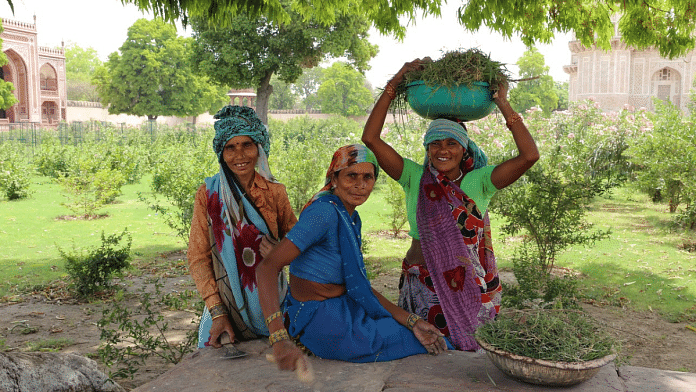New Delhi: A report released by the International Labour Organization (ILO) has painted a grim picture of India’s unemployment scenario, highlighting that nearly 83 percent of the country’s unemployed are its youth.
However, the ILO’s ‘India Employment Report 2024’ — released earlier this week and produced in partnership with the non-profit Institute of Human Development (IHD) — was also full of praise for the quality of data produced by the Indian government, based on which the UN agency has presented its findings.
This is particularly noteworthy since the standard of India’s data has been questioned by several prominent economists, such as former chief economic adviser Arvind Subramanian and former member of the Prime Minister’s Economic Advisory Council Surjit Bhalla.
ThePrint looks at what these data sources are, who produced them, and what the report says about quality.
What is the time period covered?
The report largely looks at the changes in India’s labour market over the span of nearly two decades, from 2000 to 2019. However, it also delves into the impact of the COVID-19 pandemic on employment, using available data for 2020 and 2022.
The pre-pandemic period was also broken into three time periods — 2000, 2012, and 2019 — “to highlight the changes and continuities from a long-run perspective”, the report said.
Also read: Modi govt is changing rural India. They are spending differently from MGNREGA era
What are the data sources?
The 340-page report is a comprehensive analysis of employment scenarios from 2000 to 2022 and relies heavily on government surveys.
The ILO and IHD said the Employment and Unemployment Survey of the National Sample Survey Office (NSSO) was the foundation for their study of the employment situation in India for 2000 and 2012.
In addition, it used the Periodic Labour Force Survey data, also made available by the NSSO from 2018 up to 2022, along with unit-level data.
“The unit-level data in these surveys were chiefly used to develop conceptual tools and statistical indicators appropriate for the analysis of the labour market and employment in India,” the report said.
In addition, the report relied on figures from other databases such as the Reserve Bank and the sixth edition of the India-KLEMS record, which measures the productivity of inputs in each major element of the economy — capital (K), labour (L), energy (E), material (M), and services (S). The ILO-IHD report also used data from the government’s Annual Survey of Industries repository.
Additionally, it used other, non-government data from a range of published surveys, reports and literature. One of these, the report mentioned, was the Survey on Youth and Skills that the IHD conducted in urban areas of Delhi and Ranchi in 2019.
“At various points in the report there is also disaggregated analysis of major employment trends and other labour market indicators by age, gender, education, social group and region to highlight underlying trends, especially regarding the youth working-age population,” the report said.
Also read: How India’s GDP grew by 8.4% in Q3, propelled by strong performance in industrial & services sectors
What did it say about data quality?
The report was clear that it has heavily relied on government data, as it came from official sources. It also said the data was of high quality, and lent itself to detailed analysis.
“The all-India estimates of the LFPR (labour force participation rate), the worker population ratio, the unemployment rate, including the distribution of employed persons in the country according to gender, location (rural and urban), broad industry and other categorisations, from the Employment and Unemployment Surveys and the Periodic Labour Force Surveys (PLFS) are generally found to be quite robust with reasonably low relative standard errors,” the report said.
It added that despite changes in the sample design of the PLFS, particularly in the way it stratified households, the findings were comparable with the previous Employment and Unemployment Survey results and so allowed for an analysis over time.
“This is due to the high level of precision of the all-India estimates and because the final estimates of aggregates (and accordingly, the ratios) for different domains are derived after appropriately adjusting the sample data with corresponding design-based weights at the household level,” the report said.
What is IHD and who else has it worked with?
The IHD is a non-profit autonomous institution under the Indian Society of Labour Economics (ISLE). Established in 1998, it majorly undertakes research in areas of labour and employment, livelihood, gender, health, education and other aspects of human development.
The institute also examines government policies and programmes and is recognised by ministries like the Ministry of Science and Technology. The institute is a knowledge partner with NITI Aayog and monitors the national works of the Ministries of Rural Development, Panchayati Raj and Drinking Water.
The IHD has been a regular analyser of employment scenarios in India since 2014. It has also partnered with other international organisations such as UNICEF on social protection programmes for children across India. The institute functions out of Delhi, Patna, and Ranchi.
Alakh N. Sharma and Ravi Srivastava of IHD led this employment research effort along with ILO’s Sher Verick. Sharma, professor and director of IHD Delhi, also co-authored the foreword for the report. He has a doctorate in Economics and is often a consultant with international organisations like ILO, UNDP and the World Bank.
Chaired by Professor Deepak Nayyar, IHD has close to 200 research projects, both nationally and internationally sponsored. The two most significant journals produced by the research institute are the Indian Journal of Labour Economics and the Indian Journal of Human Development.
The IHD team was closely involved in the data collection, analysis and editing of the report. IHD senior fellow Balwant Singh Mehta headed the data cell responsible for the collection, analysis and processing of all government surveys.
(Edited by Tikli Basu)
Also read: Why Tamil Nadu’s women make up nearly half of India’s female factory workforce



